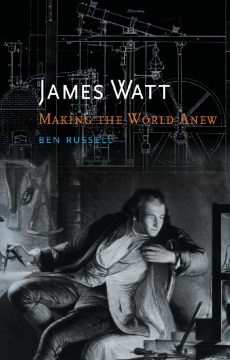
Additional Information
Book Details
Abstract
Scottish inventor and mechanical engineer James Watt (1736–1819) is best known for his pioneering work on the steam engine that became fundamental to the incredible changes and developments wrought by the Industrial Revolution. But in this new biography, Ben Russell tells a much bigger, richer story, peering over Watt’s shoulder to more fully explore the processes he used and how his ephemeral ideas were transformed into tangible artifacts. Over the course of the book, Russell reveals as much about the life of James Watt as he does a history of Britain’s early industrial transformation and the birth of professional engineering.
To record this fascinating narrative, Russell draws on a wide range of resources—from archival material to three-dimensional objects to scholarship in a diversity of fields from ceramics to antique machine-making. He explores Watt’s early years and interest in chemistry and examines Watt’s partnership with Matthew Boulton, with whom he would become a successful and wealthy man. In addition to discussing Watt’s work and incredible contributions that changed societies around the world, Russell looks at Britain’s early industrial transformation. Published in association with the Science Museum London, and with seventy illustrations, James Watt is not only an intriguing exploration of the engineer’s life, but also an illuminating journey into the broader practices of invention in the eighteenth and early nineteenth centuries.
Published in association with the Science Museum, London
“The first engineer to be commemorated in Westminster Abbey, Watt was long celebrated as a heroic figure who arrived at his epochal discoveries by virtue of lonely genius. Russell helps correct that picture by celebrating Watt as a doer and a maker, rooted in the artisanal culture of his times. Steeped in scholarship, as well as nitty-gritty knowledge of the artefacts of the Industrial Revolution, James Watt: Making the World Anew will prove fascinating to anyone who wants to know how and why steam engines were made.”
— Times Literary Supplement
“In 1924, London’s Science Museum acquired the entire workshop of engineer James Watt, left almost untouched in the attic of his house in Birmingham since his death more than a century before. The museum put a recreation of the workshop on permanent display in 2011. This workshop inspired Russell, the Science Museum’s curator of mechanical engineering, to write his engaging James Watt: Making the World Anew. . . . The diversity of Watt’s interests and activities was astonishing, even when compared with the achievements of his Enlightenment contemporaries.”
— Nature
“Russell moves beyond the steam engine to look at Watt’s many other pioneering inventions.”
— Observer
“Celebrated for his industrial inventions, Watt himself now belongs to Britain’s heritage industry. Russell has provided a refreshingly original insight into the life and activities not only of this national hero, but also of his many less famous colleagues who together transformed traditional craftsmanship into industrial innovation.”
— British Journal for the History of Science
“Comprehensive and well-researched . . . generous and fascinating collection of illustrations. . . . With a sure touch, Ben Russell makes it clear that there was far more to Watt than steam and steam engines.”
— Methodist Recorder
“Many more examples could be given, such is the richness of this book, many more than can be mentioned in a short review. . . . Russell supports his ideas with copious references, both from the literature of Watt’s own day, as well as others from scholars of today. These cover an enormous range of sources which strengthen Russell’s arguments and compel us to think seriously about the themes he proposes.”
— International Journal for the History of Engineering & Technology
“A compelling book that should be essential reading for anyone who is interested in investigating the origins of technological innovation.”
— ISIS
Ben Russell is curator of mechanical engineering at the Science Museum, London.
